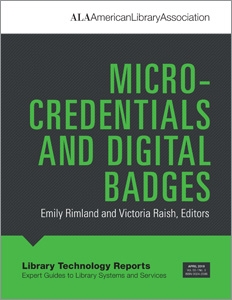Primary tabs
You don't need to be an ALA Member to purchase from the ALA Store, but you'll be asked to create an online account/profile during checkout to proceed. This Web Account is for both Members and non-Members. Note that your ALA Member discount will be applied at the final step of the checkout process.
If you are Tax-Exempt, please verify that your account is currently set up as exempt before placing your order, as our new fulfillment center will need current documentation. Learn how to verify here.
- Description
- Table of Contents
- About the authors
Digital badges, a type of micro-credential, have been heralded for the last five years as a key trend in education to provide competency-based pathways to learning. Micro-credentials allow for a unique way to teach students information literacy skills. Many libraries may be interested in implementing a micro-credentialing program but may have questions about design, mechanics, and sustainability. This report will give readers much of that background information. After reviewing the report, you will be able to
- define micro-credentials and the mechanics of using them;
- identify learning scenarios where micro-credentials can be beneficial;
- acknowledge the design considerations that are specific to badges;
- identify partnerships needed for a successful program;
- know the existing systems possible for building a micro-credentialing program for information literacy or library skills; and
- feel empowered with knowledge to begin building a program.
Chapter 1: Introduction
By Emily Rimland and Victoria Raish
Chapter 2: Overview, Definitions, and Benefits
By Emily Rimland and Victoria Raish
Chapter 3: The Badge Ecosystem
By Emily Rimland and Victoria Raish
Chapter 4: Six Roadblocks to Designing Digital Badges
By Chris Gamrat and Brett Bixler
Chapter 5: Collaborations and Partnerships
By Emily Rimland and Victoria Raish
Chapter 6: Deployment and Sustainability
By Emily Rimland and Victoria Raish
Chapter 7: Assessment
By Emily Rimland and Victoria Raish
Chapter 8: Conclusion
By Emily Rimland and Victoria Raish
Edited by Emily Rimland
Emily Rimland is an Information Literacy Librarian and Learning Technologies Coordinator at Penn State. She enjoys providing instruction, reference, and outreach services to undergraduate students and holds an MLIS from the University of Pittsburgh. Her research interests include pedagogical innovation and effective learning methodologies, the application of emerging technologies to library services, and instructional technologies. She was the founder of the ACRL Digital Badge Interest Group and was a Teaching and Learning with Technology Faculty Fellow at Penn State. She was the recipient of the 2018 Library Instruction Round Table Librarian Recognition Award.
Edited by Victoria Raish
Victoria Raish is the Online Learning Librarian for Penn State University. She received her PhD in learning, design, and technology from Penn State and her MAT from the University of Southern California. She has worked extensively with digital badges in a variety of settings, including information literacy and STEM teacher professional development. She has also presented at ACRL on digital badges and published in College and Research Libraries. Her current work involves using digital badges in introducing online students to the library and increasing information literacy instruction for online students. Her other research interests are systemic change, educational technology, and the student experience in online learning. The library digital badges at Penn State created with Emily Rimland have received national media attention.
Library Technology Reports
Published by ALA TechSource, Library Technology Reports helps librarians make informed decisions about technology products and projects. Library Technology Reports publishes eight issues annually and provides thorough overviews of current technology. Reports are authored by experts in the field and may address the application of technology to library services, offer evaluative descriptions of specific products or product classes, or cover emerging technology. Find out more information on this publication here.



